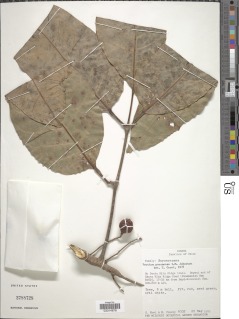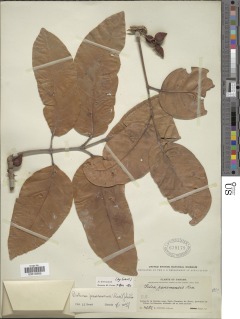

|
|
|
|
Family: Burseraceae
Chutra, more...copal
[Icica panamensis Rose] |
Description: A medium-sized, subcanopy tree with a cylindrical trunk and light brown bark. The trunk often leans some, and large individuals typically have stilt roots. Leaves are alternate, compound, with 5-9 large leaflets, including one terminal leaflet; the leaflets are quite widely spaced. The tip of the leaflet is pointed but not extended into a tip. Where the leaflet stalk meets the central leaf rachis, there is a conspicuous brown swelling. The base of the petiole is also swollen and brown, flattened vertically. Crushed leaves have a pleasant terpentine-like smell, and in young leaves the odor is quite strong. Slashed bark produces a clear resin with the same odor. Reproduction: Flowers are small, white or slightly yellow, in stalks along the branches, produced in February-March and again in from July to September. The fruit is a small capsule, pointed at one end, green then red as it matures; fruits can be found for most of the year. If the fruit is split, it also smells of terpentine. Inside is a seed surrounded in white pulp that many large birds and monkeys are attracted to. Distribution: An abundant mid-story tree at Barro Colorado, Soberania, and Sherman, and widespread at Santa Rita and the upper Chagres, but less common. Not common near Gamboa and absent from the forests near the Pacific coast. P. panamense and LK protte P. tenuifolium LK2 have opposite distributions, the latter mostly on the Pacific coast north to Barro Colorado. Similar Species: The genus Protium is easy to recognize -- common and frequently seen, and with widely-spaced leaflets that do not resemble those of the Meliaceae or Fabaceae (which have compound leaves with more densely spaced leaflets). Even tall Protium can thus be readily recognized. With leaf in hand, the brown, swollen nodes along the leaf rachis, and their terpentine-like odor, are distinctive, but all the Burseraceae share these traits. In this area, only P. panamense and LK protte P. tenuifolium LK2 have large leaflets. These two are very similar though; the extended drip-tip and lack of stilt-roots in tenuifolium are the key distinctions. Uses: The resin is used medicinally, but see LK tratas Trattinickia asperaLK2 the Burseraceae whose resin is most popular locally. Descripción: Árbol de 10 a 20 m de alto. Tronco cilíndrico y con raíces fúlcreas en la base. El desprendimiento de cualquier parte de la planta produce una savia resinosa y aromática. Hojas imparipinnadas y alternas, con 3-9 folíolos, opuestos en el raquis. Folíolos de 10-35 x 5-12 cm, ovados o lanceolados, con ápice agudo, bordes enteros y base redondeada. Los folíolos se adhieren al raquis mediante peciólulos que presentan el ápice y la base hinchada y engrosada. Pecíolo de 5-12 cm de largo, pulvinado en la base y acanalados en la parte superior. La especie es dioica. Flores amarillas y aromáticas. Frutos en cápsulas, de 2-3 cm de largo, verdes y terminados en una punta aguda, tornándose rojos y dehiscentes al madurar. Semillas cubiertas de un arilo blanco. Datos Ecológicos: La especie crece a bajas y medianas elevaciones, en bosques húmedos o muy húmedos. En Panamá se encuentra en las provincias de Bocas del Toro, Coclé, Chiriquí, Colón, Panamá y la comarca de Guna Yala. Florece y fructifica durante gran parte del año, principalmente de julio a febrero. El arilo blanco que cubre las semillas es muy apreciado por los monos, los tucanes y los loros, los cuales ayudan en la dispersión. En el suelo del bosque las semillas usualmente tienen agujeros en la testa, presumiblemente debido al ataque de insectos. Especies Parecidas: A menudo se confunde con LK protte Protium tenuifolium LK2 , pero en P. tenuifolium los folíolos tienen el ápice largo y acuminado y los frutos son cápsulas con 4-5 lados. También se puede confundir con LK tet2pa Tetragastris panamensis LK2 , pero en T. panamensis los folíolos son más pequeños y a veces de color rojizo. Usos: La madera es empleada en la carpintería, ebanistería, gabinetes, muebles, pisos y utensilios domésticos. La savia resinosa de estos árboles tiene uso medicinal, se utiliza en el tratamiento de resfriados, asma, dolores de cabeza, para extraer tórsalos y en la cicatrización de heridas. Copá Functionally unisexual tree, usually less than 12 m tall (to 40 m elsewhere), +/- stilt-rooted at base, glabrous; outer bark thin, smooth, the leaf scars on younger trees ca 5 cm broad; inner bark pinkish; sap with sweet strong odor typical of family. Leaves pinnate; petioles 6-13 cm long, flattened on upper surface, swollen at base; petiolules 1-4 (8) cm long, swollen at both ends; leaflets 3-7 (9), mostly ovate-lanceolate to oblong, bluntly short-acuminate, obtuse to rounded at base, 13-35 cm long, 6-9 (16) cm wide, coriaceous. Inflorescences paniculate (rarely racemose), axillary or terminal, sometimes cauliflorous, mostly to 15 cm long; flowers greenish-white to greenish-yellow, 4 (5)-parted, with a strong, sweet aroma; pedicels to ca 4 mm long; calyx +/- truncate or shallowly lobed, very short; petals 3 mm long, valvate, +/- spreading at anthesis, papllose-puberulent on margins, the apex acute; stamens 8 (10), 2 mm long; filaments broadened below, recessed somewhat in fleshy yellowish disk; pistil conical, short; stigma simple, almost sessile, persistent in fruit. Capsules drupaceous, red at maturity, often in a large congested cluster, ellipsoid to ovoid, apiculate, shortly stipitate, to 2.8 cm long, the valves 2 or 4, unequal, the smaller falling free at maturity; pyrene 1(4), to ca 1.5 cm long, bearing 1 or 2 seeds, greenish, covered with a thick, white, fleshy, sweet mesocarp ca 3 mm thick, attached to larger valve near apex, becoming pendent, displayed against red inner valve surface. Croat 4834, 11110. Though flowers are functionally unisexual, there are few conspicuous differences between staminate and pistillate flowers or inflorescences. Known only from Panama, probably extending into both Costa Rica and Colombia. In Panama, known only on the Atlantic slope from tropical moist forest in the Canal Zone, Bocas del Toro, and San Blas, from tropical wet forest in Colón and Coclé, and from premontane wet forest in the Canal Zone and Colón. Bocas Species Database Distribution: Islas Popa y Bastimentos Characteristics: Shrub, Tree |
|
|
|































































































